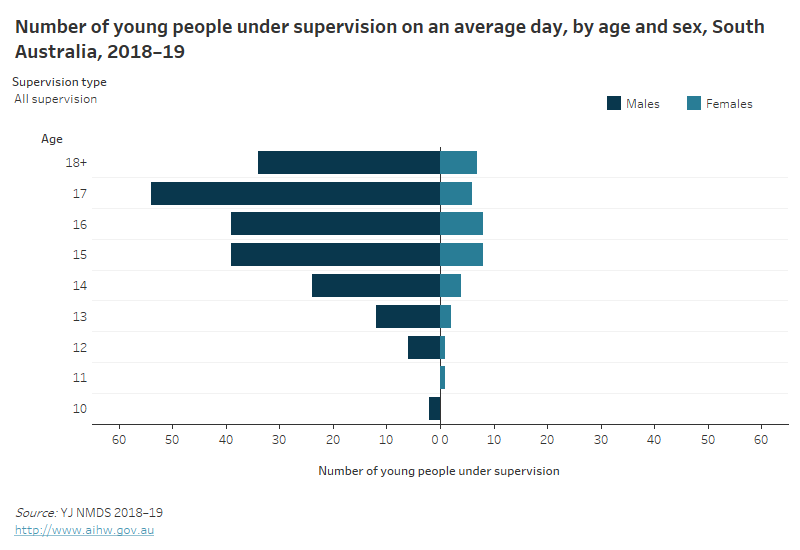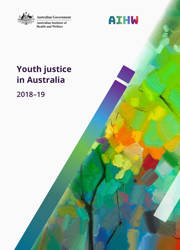South Australia
Quick facts
On an average day in 2018–19, in South Australia:
- 248 young people aged 10 and over were under youth justice supervision
- 13 per 10,000 young people aged 10–17 were under supervision
- Indigenous young people were 19 times as likely to be under supervision as non-Indigenous young people.
Of those under youth justice supervision in South Australia on an average day:
- 81% were supervised in the community, and the rest in detention
- 85% were male
- 49% of those aged 10–17 were Aboriginal or Torres Strait Islander
- 53% of those in detention were unsentenced (awaiting the outcome of their court matter or sentencing), including 4% who were already serving a sentence for a separate offence
Young people spent an average of 23 weeks under supervision during the year.
Over the 5 years to 2018–19, the number of young people under supervision on an average day fell by 33%, while the rate for those aged 10–17 fell from 19 to 13 per 10,000.
Number and rate
On an average day in 2018–19, in South Australia:
- 248 young people aged 10 and over were under youth justice supervision
- most (81%) were supervised in the community, and the rest (20%) in detention (proportions might not sum to 100% because some young people were under community-based supervision and in detention on the same day)
- the rate of supervision was 13 per 10,000 young people aged 10–17
- 10 per 10,000 young people aged 10–17 were under community-based supervision, and 2 per 10,000 were in detention (rates for detention and community-based supervision may not sum to equal all supervision due to rounding or because some young people were under community-based supervision and in detention on the same day).
Age and sex
On an average day in 2018–19, in South Australia:
- 83% of those under supervision were aged 10–17, and the rest were 18 and over
- more than 4 in 5 (85%) of those under supervision were male
- males under supervision were most likely to be aged 17, and females 15 or 16.

Aboriginal and Torres Strait Islander young people
On an average day in 2018–19, in South Australia:
- Indigenous young people made up 5% of those aged 10–17 in the general population, but 49% of those of the same age under supervision
- Indigenous young people aged 10–17 were 19 times as likely as non-Indigenous young people to be under supervision (134 per 10,000 compared with 7 per 10,000)
- Indigenous over-representation was higher in detention (28 times the non Indigenous rate).
Time under supervision
In 2018–19, in South Australia:
- the median duration of individual periods of supervision completed during the year was 95 days (almost 14 weeks)
- when all time spent under supervision during the year is considered, young people spent an average of 158 days (almost 23 weeks) under supervision.
Sentenced and unsentenced detention
On an average day in 2018–19, in South Australia:
- more than half (53%) of young people in detention were unsentenced—that is, they were awaiting the outcome of their court matter, or had been found guilty and were awaiting sentencing
- 51% of young people in detention were serving a sentence (the proportion of unsentenced and sentenced young people on an average day does not sum to 100% as young people may have changed legal status during the same day, or been on both types of orders at the same time. In South Australia, 4% of young people who were in sentenced detention had a concurrent unsentenced order).
Trends to 2018–19
Over the 5 years to 2018–19, on an average day, in South Australia:
- the number of young people under supervision fell by 33% (from 371 in 2014–15 to 248 in 2018–19), while the rate dropped from 19 to 13 per 10,000 young people aged 10–17
- in community-based supervision, the number fell by 36% (from 313 in 2014–15 to 201 in 2018–19), while the rate fell from 16 to 10 per 10,000
- in detention, the number fell 17%, while the rate fell from 3 to 2 per 10,000
- the rate of Indigenous young people under supervision fell (176 to 134 per 10,000).

More information
For more information see Youth justice.



